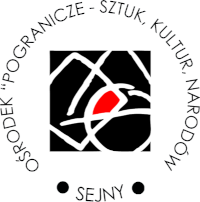The story of the tragic end of the synagogue library in Tykocin and an enclosed in a series of paintings report by an eyewitness of the extermination of the Jews in the Wasiliszki ghetto, in Belarus, gave birth to a commitment for the artist to those annihilated, a call for remembrance and at the same time reflection on the fragility and importance of memory that can be restored to us by art.
Opening of the exhibition took place on November 19th, during the Sejny All Souls' Day. The night meeting was accompanied also by remembering of those who died this past year: Piotr Szyryński, Piotr Dapkiewicz, Leonidas Donskis and Andrzej Wajda.
“Kaddish for...” Wiesław Szumiński’s Exhibition of Painting and Sculpture in the White Synagogue
Two cycles: "There was a Library...” and "Kaddish for a Girl in a White Dress".
Two stories heard and recorded by Wiesław Szumiński during his trip to the Białystok region and western Belarus became an impulse to paint two cycles of paintings and a ceramic sculptural installation: "Kaddish for a Girl in a White Dress" and "There was a Library...” presented in the exhibition.
The story of the tragic end of the synagogue library in Tykocin and an enclosed in a series of paintings report by an eyewitness of the extermination of the Jews in the Wasiliszki ghetto, in Belarus, gave birth to a commitment for the artist to those annihilated, a call for remembrance and at the same time reflection on the fragility and importance of memory that can be restored to us by art.
From the author’s journal:
It is so strange and incomprehensible. There is a synagogue, buildings, houses containing nothing. So many years, so many centuries people have lived in one place and suddenly they vanished into thin air and everything else vanished with them, too. Not a single tallith, or even a shred of clothing, not a single photo or book. Nothing.
There were chronicles of the tailors' guild and of the funeral brotherhood written down from the seventeenth century onwards or even older. And among them, there was the pride of Tykocin Jews - the parchment of the Sefer Thilim - handwritten book of psalms by an anonymous scribe, illuminated, which was exhibited during the greatest Jewish holidays, laid under the Aron Kodesh in the Great Synagogue. (...) There were countless prayer books, Torah scrolls tracks and Talmudic works.
Wiesław Szumiński, “Notes białoruski”:
... Here along the river - I see Franciszek’s finger pointing ahead of us - I can tell you a story. It was on a Sunday, when Germans started to shoot the Jews form the Wasiliszki ghetto. It was a warm day, it was summer. And people had known it earlier that something was to happen there, because they didn’t let cows graze in the meadow. And then, around nine, I could hear the workings of the machine guns. I stood, just like now and looked at where they were shooting. Suddenly I see a group of a dozen or so people, that means Jews, who separated and ran through the meadow, there, towards the woods. So they ran along the river.
And there emerged one on a motorcycle from the side of the church. He rides up and starts to shoot. He shoots a series from his gun, and then one or two fall down. And then another one, an another one. Two or three managed to get to the woods, no more. And then, this German turned and went back to Wasiliszki. And I was left alone, on this hill. It was so quiet, because they stopped shooting in the town.
And so I stood there. The meadow in front of me, as green as it was then. I can’t think what I was thinking about then. I stood there momentarily speechless and couldn’t move. Still a child, I was then. So I stand there, in this meadow and the wind blows the white skirt of this girl that fell first. It lifts this little skirt up and then falls down on the dead girl. And then it lifts it again. And silence was such and nothing more, nothing moving in this meadow. Just this little white skirt in the whole of this huge, green meadow.
Opening of the exhibition took place on November 19th, during the Sejny All Souls' Day.
Sejny All Souls' Day 2016


